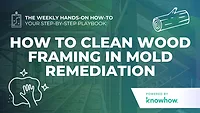Framing Options in Reconstruction
The framing market is huge. Over recent years there have been innovations in framing. These include wood I-beams, Structural Insulated Panels, different truss configurations, finger-jointed studs, and steel studs. Now a new group of framing options – treated woods with differing properties – is entering the market.

The framing market is huge. Over recent years there have been innovations in framing. These include wood I-beams, Structural Insulated Panels, different truss configurations, finger-jointed studs, and steel studs. Now a new group of framing options – treated woods with differing properties – is entering the market.
Termite and Decay Resistance
The granddaddy of treated framing options is probably borate pressure-treated wood, which has existed for many years although not been widely used. Borates are effective preservatives, recognized in the standards of the American Wood-Preservers’ Association and accepted by model building codes for interior applications. They provide resistance to damage from termites and fungal decay, and a study published in the Forest Products Journal suggests that they may also repel non-wood-destroying pests.
There are two levels of protection available with borate-treated wood: one intended for wood used where Formosan subterranean termites are present and one with a lower retention level for defense against less destructive but more common termites.
Borate-treated wood is commonly used for sill plate, but has been used for more than a decade for framing in Hawaii, where termite problems necessitated treated wood. It has been promoted for total structure protection in the continental U.S., particularly in the Southeast where the need is greatest. OSB cannot be pressure-treated so, unless a suitable preservative is incorporated into the resin binder, OSB cannot be readily protected by traditional treatments.
To identify borate-treated wood, producers typically add a blue dye to the treating solution. This allows contractors and building inspectors to differentiate borate-treated components from untreated wood.
Fire Retardance
Fire retardant treated (FRT) wood has been used for decades, mandated by building codes attempting to limit the spread of fire and reduce smoke generation in commercial and institutional buildings and in multi-family housing.
Some FRT wood has an added benefit: in addition to its fire retardance, it has EPA-registered resistance to termites and fungal decay. With this framing, the owner gets a benefit even if a fire never occurs, as owners hope will be the case.
Some dealers stock FRT wood. It is also available from producers as a special order.
Mold Resistance
Of high interest at this time is mold prevention, or, at least, mold management. Building owners have mold concerns, and contractors worry about mold liability. It has been reported that 10,000 mold lawsuits are pending in the U.S.
Mold-resistant wood can help minimize the growth of mold and the likelihood of liability claims. To this end, manufacturers have recently introduced anti-mold coatings for framing lumber, trusses, and engineered wood products. The best of these are applied by spray or dip at central locations where the coverage can be controlled and quality monitored, rather than being applied at each jobsite.
As with borate treatment, mold-resistant coatings usually contain a dye, either green or blue, for identification during construction.
The Ultimate Stud?
The ultimate wood stud may be lumber that is pressure-treated with a fire retardant and then coated with an anti-mold solution. In a survey conducted by Good Housekeeping, nearly a quarter of 1200 respondents said they would “definitely” pay 4-7% more for a house with framing that resists fire, produces less smoke, and fights termites and mold. Another 60% answered by saying they “probably” would.
A demonstration house in Baton Rouge, the Louisiana House, includes three of the above options: borate pressure-treated lumber for framing, fire retardant treated plywood around a fireplace, and SIPs with OSB skins coated with an anti-mold product. The house also features “optimum engineered framing,” designed to handle high wind loads. More information is available at www.louisianahouse.org.
Yet another framing option has generated attention for the time it saves in erecting steel stud systems. Wood backing is often required in such buildings to support cabinets, handrails, and wall fixtures. A modular wood backing system has been introduced that attaches to studs, precluding the need for custom-cutting each piece of blocking.
Looking for a reprint of this article?
From high-res PDFs to custom plaques, order your copy today!






